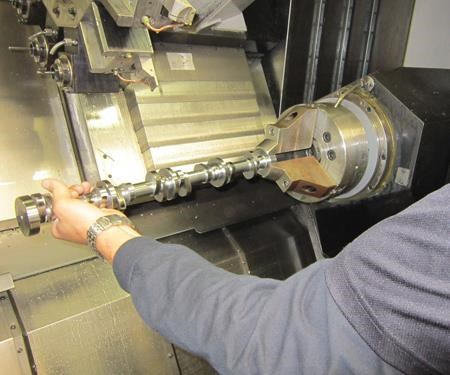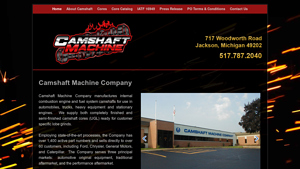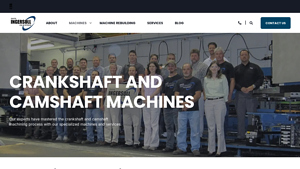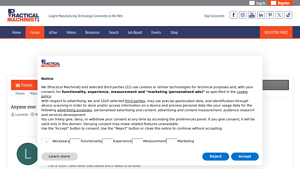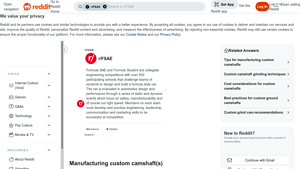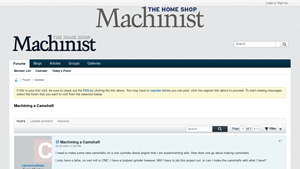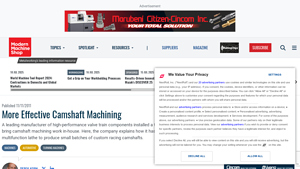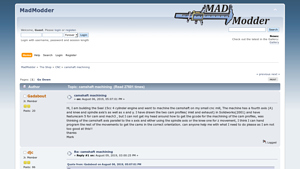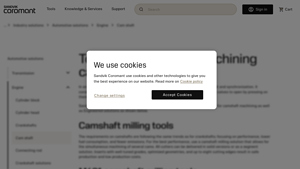Camshaft Machining Guide: Type, Cost, Top List…
Introduction: Navigating the Global Market for camshaft machining
In an increasingly competitive global market, sourcing high-quality camshaft machining services can present significant challenges for B2B buyers. With a plethora of suppliers and varying standards of quality, making an informed decision is critical for ensuring the performance and longevity of internal combustion engines across multiple industries. This comprehensive guide aims to equip international buyers, particularly those from Africa, South America, the Middle East, and Europe, with the insights necessary to navigate the complexities of camshaft machining.
We will delve into various types of camshafts, their applications across automotive, military, marine, and industrial sectors, and the nuances of supplier vetting processes. Additionally, the guide will highlight cost factors and the importance of certifications such as ISO 9001:2015 and IATF 16949:2016 that can impact supplier reliability. By addressing these essential elements, this guide empowers B2B buyers to make strategic purchasing decisions that align with their operational needs and quality standards.
As global markets continue to evolve, understanding the intricacies of camshaft machining is not just beneficial—it’s essential. With the right knowledge and resources, buyers can forge strong partnerships with suppliers that prioritize quality and on-time delivery, ultimately enhancing their competitive edge in their respective industries.
Understanding camshaft machining Types and Variations
| Type Name | Key Distinguishing Features | Primary B2B Applications | Brief Pros & Cons for Buyers |
|---|---|---|---|
| Forged Camshafts | Made from solid steel, heat-treated for strength | Automotive, Heavy Equipment, Military | Pros: High durability; Cons: Higher cost due to material and processing. |
| Machined Camshafts | Precision machined from bar stock or castings | Racing, Custom Applications | Pros: Customizable profiles; Cons: May require additional processes for hardness. |
| Prototype Camshafts | Designed for testing and validation | R&D, Automotive Development | Pros: Fast turnaround for testing; Cons: Limited lifespan for production use. |
| Custom Camshaft Cores | Semi-finished cores tailored for specific needs | Aftermarket, Specialty Equipment | Pros: Flexibility in finishing; Cons: May require multiple suppliers for completion. |
| Performance Camshafts | Engineered for high RPM and power | Motorsports, Performance Tuning | Pros: Enhanced performance; Cons: May not be suitable for everyday vehicles. |
What Are Forged Camshafts and Their B2B Relevance?
Forged camshafts are crafted from solid steel and undergo a heat treatment process to enhance their strength and durability. This type is particularly suitable for applications demanding high-performance and reliability, such as automotive engines and heavy machinery. B2B buyers should consider the longevity and performance capabilities of forged camshafts, despite their higher initial costs, as they often lead to lower maintenance expenses over time.
How Do Machined Camshafts Differ in Production?
Machined camshafts are produced by precision machining techniques from bar stock or castings. These camshafts are ideal for racing and custom applications where specific profiles are required. Buyers should evaluate the customization options available, as well as the potential need for additional hardening processes, which can affect lead times and costs.
What Are the Benefits of Prototype Camshafts?
Prototype camshafts are essential for research and development, allowing manufacturers to test and validate designs before mass production. They are typically produced quickly to facilitate rapid testing cycles. B2B buyers should consider the importance of prototyping in their development processes, recognizing that while these camshafts are not intended for long-term use, they are invaluable for ensuring design accuracy and performance.
Why Choose Custom Camshaft Cores?
Custom camshaft cores are semi-finished products that can be tailored to meet specific customer requirements. They are particularly useful in the aftermarket sector or for specialty equipment. Buyers should weigh the benefits of flexibility in the finishing processes against the potential complexity of working with multiple suppliers to complete the final product.
What Makes Performance Camshafts Unique?
Performance camshafts are specifically engineered to enhance engine power and efficiency, often utilized in motorsports and performance tuning. These camshafts are designed to operate at higher RPMs and can significantly improve vehicle performance. B2B buyers must assess whether the performance benefits justify the investment, especially if the camshafts may not be appropriate for standard or daily-use vehicles.
Key Industrial Applications of camshaft machining
| Industry/Sector | Specific Application of camshaft machining | Value/Benefit for the Business | Key Sourcing Considerations for this Application |
|---|---|---|---|
| Automotive | Production of OEM and aftermarket camshafts | Ensures optimal engine performance and compliance with regulations | Quality certification (ISO 9001:2015, IATF 16949:2016), lead times, and customization capabilities |
| Military | Manufacturing camshafts for defense vehicles | Provides reliable performance under extreme conditions | Compliance with military standards, durability, and precision engineering |
| Marine | High-performance camshafts for marine engines | Enhances fuel efficiency and power output in harsh environments | Resistance to corrosion, specialized engineering for watercraft applications |
| Heavy Equipment | Custom camshafts for construction machinery | Increases operational efficiency and extends machinery lifespan | Heavy-duty specifications, material quality, and adaptability to various machinery types |
| Rail | Large camshafts for locomotives and rail systems | Improves reliability and reduces downtime in rail operations | Size specifications, heat treatment processes, and turnaround time for production |
How is Camshaft Machining Used in the Automotive Industry?
In the automotive sector, camshaft machining plays a crucial role in producing both original equipment manufacturer (OEM) and aftermarket parts. Companies need to ensure that their camshafts meet stringent performance and regulatory standards, which involves precision machining to achieve specific lobe profiles. Buyers from regions like Europe and the Middle East may prioritize suppliers with certifications such as ISO 9001:2015 and IATF 16949:2016 to guarantee quality and reliability. Additionally, the ability to customize camshaft designs for various engine types is a significant advantage.
What are the Applications of Camshaft Machining in the Military Sector?
Military applications require camshafts that can withstand extreme conditions and high-stress environments. Machining for defense vehicles often involves producing custom camshafts that meet rigorous military specifications for durability and performance. International buyers must consider suppliers that demonstrate compliance with defense standards and can deliver precision-engineered components. The reliability of these camshafts is critical, as they directly impact the operational effectiveness of military machinery.
How Does Camshaft Machining Benefit Marine Applications?
In the marine industry, camshaft machining is essential for producing high-performance components that enhance engine efficiency and power output. Marine camshafts must be designed to resist corrosion and operate effectively in harsh environments. Buyers in this sector, particularly from coastal regions in Africa and South America, should seek suppliers with expertise in marine engineering and the ability to provide customized solutions that meet specific performance criteria.
What Role Does Camshaft Machining Play in Heavy Equipment?
Heavy equipment manufacturers rely on camshaft machining to produce robust components that improve operational efficiency and extend the lifespan of machinery. The customization of camshafts to fit various types of construction and mining equipment is vital for performance optimization. Buyers must consider the durability of materials used and the supplier’s ability to meet heavy-duty specifications. Timely delivery and quality assurance are also critical factors in sourcing decisions.
How is Camshaft Machining Applied in the Rail Industry?
In the rail sector, camshaft machining is focused on producing large components for locomotives and rail systems. These camshafts must undergo deep case heat treatment to ensure they can handle the heavy loads and stresses associated with rail operations. Buyers need to prioritize suppliers that can meet specific size and performance requirements, as well as those who can provide quick turnaround times for production to minimize downtime in rail services.
3 Common User Pain Points for ‘camshaft machining’ & Their Solutions
Scenario 1: Difficulties in Sourcing High-Quality Camshaft Machining Services
The Problem: Many B2B buyers, particularly in regions like Africa and South America, struggle to find reliable camshaft machining providers who can meet their specific quality standards and delivery timelines. With varying manufacturing capabilities across suppliers, buyers often face the risk of receiving subpar products that can lead to engine failures or performance issues. This uncertainty can be exacerbated by geographical distance, language barriers, and differing regulatory standards, making it challenging to establish trust and ensure quality.
The Solution: To effectively source high-quality camshaft machining services, buyers should conduct thorough due diligence on potential suppliers. This includes requesting certifications such as ISO 9001:2015 and IATF 16949:2016, which demonstrate a commitment to quality management and process improvement. Engaging with suppliers who have a proven track record in the automotive industry is crucial. Buyers can also benefit from visiting production facilities, if feasible, to assess machinery, workforce capabilities, and quality control processes firsthand. Building a long-term relationship with a supplier that understands regional requirements and can adapt to specific needs will yield better results and reliability.
Scenario 2: Inconsistent Performance Across Different Engine Applications
The Problem: Buyers often encounter challenges when camshafts designed for one type of engine do not perform as expected in another application. This can lead to operational inefficiencies, increased maintenance costs, and potential downtimes, especially when transitioning between automotive, marine, or heavy equipment applications. The intricacies of camshaft profiles and their relationship with engine timing and performance make this an ongoing concern for B2B buyers.
The Solution: To mitigate this risk, it is essential for buyers to collaborate closely with camshaft manufacturers during the design and prototyping phases. Providing detailed specifications and performance requirements based on the intended application will allow manufacturers to tailor camshaft designs accordingly. Utilizing advanced simulation tools during the design process can help predict performance outcomes across different engine types. Additionally, establishing a feedback loop post-installation can help manufacturers refine their products based on real-world performance data, leading to continuous improvement and innovation.
Scenario 3: Navigating Regulatory Compliance and Quality Assurance
The Problem: International buyers often face regulatory hurdles related to quality assurance and compliance with local and international standards, particularly in regions with stringent automotive safety regulations. Ensuring that the camshafts meet these standards while also maintaining cost-effectiveness can be a significant pain point. Non-compliance can result in hefty fines, recalls, and damage to brand reputation.
The Solution: To navigate these complexities, B2B buyers should prioritize sourcing from manufacturers that are not only compliant with international standards but also have a deep understanding of local regulations. This can involve engaging legal or compliance experts who specialize in the automotive sector to help interpret the requirements. Additionally, buyers should work with manufacturers that provide comprehensive documentation for traceability and compliance, including test results and quality audits. Regular audits and reviews of supplier practices can help ensure ongoing compliance and identify any areas for improvement, fostering a culture of quality that benefits both parties.
Strategic Material Selection Guide for camshaft machining
What Are the Key Materials for Camshaft Machining?
When selecting materials for camshaft machining, it’s essential to consider properties that influence performance, durability, and manufacturing complexity. Below are analyses of four common materials used in camshaft production, focusing on their key properties, advantages, disadvantages, and considerations for international B2B buyers.
1. Alloy Steel
Key Properties:
Alloy steel is known for its high strength, toughness, and wear resistance. It typically has a temperature rating of up to 400°C and can withstand high pressure, making it suitable for demanding applications.
Pros & Cons:
The primary advantage of alloy steel is its durability, which is crucial for camshafts subjected to high stress. However, it can be more expensive than other materials and may require complex heat treatment processes to achieve optimal hardness.
Impact on Application:
Alloy steel camshafts perform well in high-performance automotive engines, where precise timing and strength are critical. They are compatible with a variety of lubricants and fuel types.
Considerations for International Buyers:
Buyers should ensure compliance with international standards such as ASTM A29/A29M for alloy steel. Additionally, understanding local sourcing capabilities and manufacturing practices in regions like Europe and the Middle East is crucial for procurement.
2. Cast Iron
Key Properties:
Cast iron offers excellent wear resistance and good machinability. It can handle temperatures up to 300°C and provides inherent damping properties, reducing vibrations in the engine.
Pros & Cons:
The cost-effectiveness of cast iron makes it a popular choice, especially for mass production. However, its brittleness can be a drawback, making it less suitable for high-performance applications where shock loading is a concern.
Impact on Application:
Cast iron camshafts are often used in standard automotive applications and heavy machinery. They are compatible with various engine oils and can operate effectively in moderate temperature ranges.
Considerations for International Buyers:
Buyers should verify compliance with standards like DIN EN 1561. In regions like Africa and South America, sourcing reliable suppliers who can meet these standards is essential.
3. Billet Aluminum
Key Properties:
Billet aluminum is lightweight and offers good corrosion resistance. It has a temperature rating of around 150°C, which is suitable for specific applications but may limit its use in high-temperature environments.
Pros & Cons:
The primary advantage of aluminum is its weight reduction, which can enhance engine performance. However, its lower strength compared to steel can be a limitation, particularly in high-stress applications.
Impact on Application:
Aluminum camshafts are often used in racing and performance applications where weight savings are crucial. They are compatible with various fuels and lubricants but may require anodizing for enhanced durability.
Considerations for International Buyers:
Buyers should be aware of the need for compliance with standards like ASTM B221. In markets such as Europe, preferences may lean towards aluminum for performance applications, necessitating a focus on suppliers with expertise in this material.
4. Forged Steel
Key Properties:
Forged steel provides superior strength and impact resistance, with a temperature rating exceeding 500°C. This makes it ideal for high-performance and heavy-duty applications.
Pros & Cons:
The key advantage of forged steel is its exceptional durability and reliability under extreme conditions. However, the forging process can be costly and complex, which may affect pricing for smaller production runs.
Impact on Application:
Forged steel camshafts are commonly used in high-performance automotive engines and heavy machinery, where strength is paramount. They are compatible with various media, including high-performance lubricants.
Considerations for International Buyers:
International buyers should ensure compliance with standards like ASTM A105. Understanding regional manufacturing capabilities, especially in Europe and the Middle East, can help in selecting the right supplier.
Summary Table
| Material | Typical Use Case for camshaft machining | Key Advantage | Key Disadvantage/Limitation | Relative Cost (Low/Med/High) |
|---|---|---|---|---|
| Alloy Steel | High-performance automotive engines | Exceptional strength and durability | Higher cost and complex processing | High |
| Cast Iron | Standard automotive and heavy machinery | Cost-effective and good machinability | Brittle, less suitable for high-stress | Medium |
| Billet Aluminum | Racing and performance applications | Lightweight, enhances performance | Lower strength than steel | Medium |
| Forged Steel | High-performance and heavy-duty engines | Superior strength and impact resistance | Costly and complex forging process | High |
This strategic material selection guide provides valuable insights for B2B buyers, enabling them to make informed decisions based on performance requirements, cost considerations, and compliance with international standards.
In-depth Look: Manufacturing Processes and Quality Assurance for camshaft machining
What Are the Key Stages in the Manufacturing Process of Camshaft Machining?
The manufacturing process for camshaft machining is a complex procedure that encompasses several critical stages. Each stage is designed to ensure that the final product meets the stringent demands of various industries, including automotive, military, and heavy equipment.
1. Material Preparation: What Materials Are Used for Camshaft Machining?
The first step in camshaft machining involves selecting the appropriate material, typically high-grade steel or iron alloys. These materials are chosen for their ability to withstand high temperatures and stress, which are common in engine components. Before machining, the raw materials are cut into manageable sizes and inspected for any defects that could affect the final product.
2. Forming: How Are Camshafts Shaped?
The forming stage involves the initial shaping of the camshaft, often utilizing techniques such as forging or casting. Forging is preferred for its ability to improve the material’s grain structure, which enhances strength and durability. Once the camshaft is forged, it undergoes rough machining to create a basic shape before the intricate details of the lobes and bearing surfaces are added.
3. Assembly: What Role Does Assembly Play in Camshaft Production?
During the assembly phase, any additional components, such as gears or sensors, may be attached to the camshaft if required by the design specifications. This step is critical for camshafts that will be used in complex applications, such as variable valve timing systems.
4. Finishing: What Techniques Are Used for Final Touches?
Finishing is crucial for achieving the precise tolerances and surface finishes required for optimal performance. This stage typically includes processes like grinding, polishing, and heat treatment. Advanced techniques such as CNC machining and Swiss turning are often employed to ensure accuracy in the profile of the lobes and overall dimensions of the camshaft.
How Is Quality Assurance Implemented in Camshaft Machining?
Quality assurance (QA) is a vital component of the camshaft machining process, ensuring that products meet international standards and customer specifications. Effective QA processes help mitigate risks and enhance product reliability.
Relevant International Standards: Which Certifications Should B2B Buyers Look For?
B2B buyers should prioritize suppliers with certifications such as ISO 9001:2015 and IATF 16949:2016. These certifications indicate that the manufacturing processes are consistent and adhere to international quality management standards. Additionally, industry-specific certifications like CE and API can be crucial for specific applications, particularly in the automotive and energy sectors.
Key Quality Control Checkpoints: What Are the Stages of Quality Inspection?
Quality control (QC) in camshaft machining typically involves several checkpoints throughout the manufacturing process:
- Incoming Quality Control (IQC): This initial inspection ensures that raw materials meet the required specifications before production begins.
- In-Process Quality Control (IPQC): During manufacturing, regular inspections are conducted to verify that the machining processes remain within acceptable limits.
- Final Quality Control (FQC): After production, the finished camshafts undergo rigorous testing to confirm that they meet all design and performance specifications.
Common Testing Methods: How Are Camshafts Tested for Quality?
Testing methods can vary, but common practices include dimensional checks using coordinate measuring machines (CMM), surface finish assessments, and hardness testing. Non-destructive testing (NDT) methods, such as ultrasonic testing and magnetic particle inspection, are also employed to identify any internal flaws without damaging the components.
How Can B2B Buyers Verify Supplier Quality Control?
For international B2B buyers, especially those from regions like Africa, South America, the Middle East, and Europe, verifying a supplier’s quality control processes is essential for ensuring product reliability.
What Are the Best Practices for Supplier Audits?
Conducting supplier audits is one of the most effective ways to assess quality control practices. Buyers should look for:
- Comprehensive Audit Reports: Suppliers should provide detailed reports from recent audits that outline their quality management systems and compliance with international standards.
- Third-Party Certifications: Ensure that the supplier has valid certifications from recognized third-party organizations, which can provide additional assurance of quality practices.
- Visits to Manufacturing Facilities: Whenever possible, arrange visits to the supplier’s production facilities to observe the manufacturing processes and quality control systems in action.
What Are the Nuances of Quality Control for International Transactions?
When dealing with suppliers across different countries, B2B buyers must be aware of specific nuances related to quality control:
- Cultural Differences: Understanding local practices and attitudes toward quality can provide insights into how rigorously a supplier adheres to quality standards.
- Regulatory Compliance: Different countries may have varying regulations regarding product standards. It’s crucial to confirm that the supplier complies with both local and international regulations applicable to the camshaft industry.
- Language Barriers: Effective communication is vital for ensuring that quality specifications are clearly understood and met. It may be beneficial to engage a translator or local expert when negotiating terms and specifications.
By focusing on these manufacturing processes and quality assurance practices, B2B buyers can make informed decisions, ensuring they partner with suppliers who deliver high-quality camshafts that meet their specific needs.
Practical Sourcing Guide: A Step-by-Step Checklist for ‘camshaft machining’
Introduction
In the competitive landscape of camshaft machining, making informed sourcing decisions is critical for B2B buyers. This checklist is designed to guide you through the essential steps of procuring camshaft machining services, ensuring that you select a supplier who meets your technical requirements and quality standards.
Step 1: Define Your Technical Specifications
Clearly outline the specifications for the camshafts you need. This includes dimensions, material types, tolerances, and any specific performance requirements. Having a detailed specification helps suppliers understand your needs and enables accurate quotations.
- Consider material properties: Different applications may require specific materials, such as alloy steel or cast iron, to withstand varying operational stresses.
- Identify lobe profiles: Whether you need custom grinds or standard profiles, specifying these early on saves time and reduces the risk of miscommunication.
Step 2: Research Potential Suppliers
Conduct thorough research to identify potential suppliers who specialize in camshaft machining. Look for companies with proven expertise in your industry, as this can significantly impact quality and delivery.
- Check their portfolio: Review previous projects to gauge their capabilities and the variety of camshafts they have produced.
- Evaluate industry experience: Suppliers with a long history in automotive, military, or marine applications often have the necessary expertise to meet stringent requirements.
Step 3: Verify Supplier Certifications
Before proceeding, ensure that your selected suppliers have relevant certifications, such as ISO 9001:2015 or IATF 16949:2016. These certifications demonstrate a commitment to quality management systems and consistent performance.
- Request documentation: Ask for copies of their certifications to validate their compliance with industry standards.
- Understand their quality control processes: Inquire about the measures they take to ensure quality throughout the machining process, from material selection to final inspection.
Step 4: Evaluate Production Capabilities
Assess the supplier’s production capabilities to ensure they can meet your volume requirements, whether for prototypes or large-scale production runs.
- Inquire about technology: Suppliers using advanced machining techniques, like 4- and 5-axis machining, are likely to deliver higher precision and efficiency.
- Check lead times: Understanding their production timelines will help you align your procurement schedule with your operational needs.
Step 5: Request Samples and Prototypes
Before making a long-term commitment, ask suppliers for samples or prototypes of their camshaft products. This step is crucial for assessing quality and fit for your specific application.
- Evaluate performance: Testing samples allows you to confirm that the product meets your specifications and performance expectations.
- Assess finish and tolerances: Pay attention to the surface finish and dimensional accuracy, as these factors can significantly affect the camshaft’s functionality.
Step 6: Negotiate Terms and Pricing
Once you have shortlisted suppliers, enter negotiations regarding pricing, payment terms, and delivery schedules. Effective negotiation can lead to favorable terms that benefit your business.
- Discuss volume discounts: If you anticipate large orders, inquire about bulk pricing to optimize your budget.
- Clarify warranty and support: Ensure you understand the warranty terms and the level of after-sales support provided, which can be crucial for ongoing operations.
Step 7: Establish a Communication Plan
Finally, establish a clear communication plan with your selected supplier. Effective communication is essential for addressing any issues that may arise during production and ensuring timely updates.
- Set regular check-ins: Schedule periodic meetings or updates to monitor progress and address concerns promptly.
- Utilize project management tools: Consider using collaborative tools to streamline communication and documentation, enhancing transparency throughout the process.
By following this checklist, B2B buyers can make informed decisions when sourcing camshaft machining services, ensuring they partner with suppliers who meet their technical and quality requirements.
Comprehensive Cost and Pricing Analysis for camshaft machining Sourcing
What Are the Key Cost Components in Camshaft Machining?
When sourcing camshaft machining services, understanding the cost structure is essential for effective budgeting and negotiation. The primary cost components include:
-
Materials: The choice of raw materials significantly impacts costs. High-performance camshafts often require specialized alloys or heat-treated steels, which are more expensive than standard materials. This consideration is crucial for industries demanding stringent quality standards, such as automotive and military.
-
Labor: Skilled labor is required for both the machining process and quality control. Labor costs can vary widely based on geographic location and the skill level of the workforce. For example, labor rates in Europe may be higher than those in South America or Africa, influencing the overall cost.
-
Manufacturing Overhead: This includes expenses related to the facility, utilities, equipment maintenance, and administrative costs. Efficient operations can help minimize overhead, but buyers should be aware that advanced manufacturing processes may incur higher overhead costs.
-
Tooling: Custom tooling can be a significant upfront cost, especially for unique camshaft designs or specifications. The complexity of the camshaft profile can also affect tooling costs, as more intricate designs require more sophisticated equipment.
-
Quality Control (QC): Ensuring that camshafts meet required specifications involves rigorous testing and inspection. The costs associated with QC processes, including certifications (e.g., ISO 9001:2015), should be factored into the overall pricing.
-
Logistics: Transportation and shipping costs can add to the total expenditure, especially for international shipments. Consideration of Incoterms is vital, as they define the responsibilities of buyers and suppliers regarding shipping, insurance, and tariffs.
-
Margin: Suppliers typically add a profit margin to the total costs. This margin can vary based on market conditions, competition, and the supplier’s pricing strategy.
How Do Price Influencers Affect Camshaft Machining Costs?
Several factors can influence the pricing of camshaft machining services:
-
Volume/MOQ: Higher order volumes often lead to lower unit costs due to economies of scale. Suppliers may offer better pricing for large batch orders, so it’s beneficial for buyers to negotiate minimum order quantities (MOQs) that align with their needs.
-
Specifications and Customization: Custom designs or specific performance requirements can drive up costs. Standard camshaft profiles typically have lower prices compared to bespoke solutions.
-
Materials and Quality Certifications: The use of premium materials and adherence to international quality standards can significantly increase costs. Buyers should assess their quality requirements against their budget constraints.
-
Supplier Factors: The reputation and experience of the supplier can also influence pricing. Established suppliers with a track record of quality may charge more, but they often provide added value through reliability and superior service.
-
Incoterms: Understanding the implications of different Incoterms can help buyers manage shipping costs and responsibilities effectively, influencing overall expenditure.
What Are Essential Buyer Tips for Cost Efficiency in Camshaft Machining?
To maximize cost efficiency when sourcing camshaft machining services, consider the following tips:
-
Negotiate Pricing: Engage in discussions about pricing structures, especially if you can commit to larger volumes or long-term contracts. Suppliers may be open to discounts or better terms for reliable customers.
-
Evaluate Total Cost of Ownership (TCO): Beyond the initial purchase price, consider the TCO, which includes maintenance, durability, and performance of the camshafts. Investing in higher-quality products may lead to lower long-term costs.
-
Understand Pricing Nuances for International Buyers: Be aware that prices can vary significantly based on regional market conditions, currency fluctuations, and trade tariffs. For buyers in Africa, South America, the Middle East, and Europe, understanding these nuances is crucial for effective budgeting.
-
Request Detailed Quotes: When sourcing from multiple suppliers, request detailed quotes that break down costs. This transparency allows for better comparison and informed decision-making.
-
Consider Local vs. International Suppliers: While international suppliers may offer competitive pricing, local suppliers can reduce shipping costs and lead times. Evaluate the trade-offs between cost and convenience.
Disclaimer for Indicative Prices
The pricing structures discussed herein are indicative and can fluctuate based on market dynamics, supplier negotiations, and specific project requirements. It is advisable for buyers to conduct thorough research and obtain personalized quotes to ensure the most accurate cost assessments for their camshaft machining needs.
Alternatives Analysis: Comparing camshaft machining With Other Solutions
In the competitive landscape of manufacturing and engineering, the choice of camshaft production methods can significantly impact the quality, cost, and efficiency of engine performance. While camshaft machining is a widely adopted solution, various alternatives exist that may better align with specific project requirements or operational goals. This section will compare camshaft machining with other viable solutions, helping B2B buyers make informed decisions.
| Comparison Aspect | Camshaft Machining | Forging | 3D Printing |
|---|---|---|---|
| Performance | High precision; customizable designs | Strong structural integrity; less precision | Moderate precision; rapid prototyping |
| Cost | Moderate to high; tooling and setup costs | Generally lower; bulk production advantageous | Variable; can be high for materials and speed |
| Ease of Implementation | Requires skilled labor and equipment | Requires specialized forging tools | Easy for small runs; complex for large quantities |
| Maintenance | Moderate; regular calibration needed | Low; durable with minimal wear | High; post-processing often required |
| Best Use Case | Custom, high-performance applications | High-volume production, standard designs | Prototyping and complex geometries |
What are the Benefits and Drawbacks of Forging as an Alternative to Camshaft Machining?
Forging is a traditional method that involves shaping metal using compressive forces. It offers significant advantages in terms of durability and strength, making it ideal for high-volume production runs. Forged camshafts are typically less prone to wear and tear, which can be beneficial in demanding applications such as heavy machinery or automotive engines. However, the initial setup costs can be high, and the process lacks the precision of machining. Customization options are limited compared to machining, which may not suit all specialized requirements.
How Does 3D Printing Compare to Camshaft Machining for Camshaft Production?
3D printing represents a cutting-edge alternative that allows for rapid prototyping and the creation of complex geometries that may be difficult or impossible to achieve through traditional methods. This technology is particularly advantageous for small production runs or unique designs, enabling manufacturers to quickly iterate and test new concepts. However, the material costs can be high, and the strength of 3D-printed parts may not match that of forged or machined components. Furthermore, post-processing is often required to achieve the desired finish, adding to the overall maintenance effort.
Conclusion: How Can B2B Buyers Choose the Right Camshaft Production Solution?
When considering camshaft production methods, B2B buyers must evaluate their specific needs, including performance requirements, budget constraints, and production volumes. Camshaft machining offers precision and customization, making it suitable for high-performance applications. Forging is ideal for high-volume needs where durability is paramount, while 3D printing excels in prototyping and intricate designs. By assessing these factors against the strengths and weaknesses of each alternative, buyers can make informed decisions that align with their operational goals and maximize their investment in camshaft production.
Essential Technical Properties and Trade Terminology for camshaft machining
What Are the Key Technical Properties in Camshaft Machining?
In the realm of camshaft machining, several critical specifications dictate the performance, durability, and compatibility of the final product. Understanding these properties is essential for B2B buyers to ensure they procure camshafts that meet their specific application needs.
1. Material Grade
The material grade of a camshaft typically refers to the type of steel used, such as 8620 or 4130 alloy steel. Higher-grade materials can withstand greater stress and heat, which is vital in high-performance applications like racing or heavy machinery. Selecting the appropriate material grade ensures longevity and reliability, reducing the risk of premature failure.
2. Tolerance
Tolerance indicates the allowable deviation from a specified dimension. In camshaft machining, tight tolerances (often within ±0.001 inches) are crucial for ensuring proper fit and function within the engine. Tighter tolerances result in better performance, as they reduce the likelihood of mechanical issues, such as valve timing errors.
3. Surface Finish
The surface finish of a camshaft affects its wear resistance and friction characteristics. Common surface finish specifications, such as Ra (Roughness Average), influence how smoothly the cam operates within the engine. A smoother finish can reduce friction, leading to improved efficiency and performance.
4. Hardness
Hardness is a measure of a material’s resistance to deformation and wear. In camshaft machining, hardness is typically achieved through heat treatment processes like induction hardening. This property is essential for ensuring the camshaft can endure the intense forces and wear associated with engine operation, thus enhancing its durability.
5. Lobe Profile
The lobe profile defines the shape and dimensions of the camshaft lobes, which control valve timing and lift. Precise lobe profiling is critical for optimizing engine performance, affecting factors such as horsepower and torque. Custom lobe profiles can be designed for specific applications, making it imperative to communicate these requirements clearly during the procurement process.
What Are Common Trade Terms Used in Camshaft Machining?
Navigating the camshaft machining industry involves understanding specific jargon that can impact procurement and contractual agreements. Familiarity with these terms will empower B2B buyers to make informed decisions.
1. OEM (Original Equipment Manufacturer)
An OEM refers to a company that produces parts or equipment that may be marketed by another manufacturer. In the context of camshafts, OEMs typically supply components directly to automotive manufacturers. Understanding whether a supplier is an OEM can help buyers ascertain the quality and compatibility of the camshafts.
2. MOQ (Minimum Order Quantity)
MOQ represents the smallest quantity of a product that a supplier is willing to sell. For camshaft machining, knowing the MOQ is crucial for budgeting and inventory management. Suppliers may have different MOQs based on production capabilities, which can affect a buyer’s ability to meet demand.
3. RFQ (Request for Quotation)
An RFQ is a formal process in which buyers solicit price quotes from suppliers for specific products or services. In camshaft machining, submitting an RFQ allows buyers to compare costs, lead times, and specifications, facilitating better decision-making when selecting suppliers.
4. Incoterms (International Commercial Terms)
Incoterms are a set of predefined commercial terms used in international trade to clarify the responsibilities of buyers and sellers. Understanding these terms, such as FOB (Free On Board) or CIF (Cost, Insurance, and Freight), is essential for B2B buyers engaging in global procurement, as they dictate shipping responsibilities and risk management.
5. Lead Time
Lead time refers to the amount of time required from placing an order to receiving the product. In camshaft machining, lead times can vary based on factors like complexity, order size, and supplier capacity. Understanding lead times is vital for planning production schedules and ensuring timely delivery of components.
By grasping these essential technical properties and trade terminology, B2B buyers can enhance their procurement processes, ensuring they source high-quality camshafts tailored to their specific requirements.
Navigating Market Dynamics and Sourcing Trends in the camshaft machining Sector
What Are the Key Trends Shaping the Camshaft Machining Market?
The camshaft machining sector is experiencing significant growth driven by the global automotive industry’s shift toward high-performance engines and stringent emissions regulations. As manufacturers prioritize efficiency and performance, there is a rising demand for precision-engineered camshafts. This trend is particularly evident in regions such as Europe and the Middle East, where advanced automotive technologies are prevalent. B2B buyers from Africa and South America are also increasingly investing in camshaft machining to support their expanding automotive markets.
Emerging technologies, such as additive manufacturing and advanced CNC machining, are revolutionizing the production processes within the camshaft machining sector. These innovations not only enhance manufacturing capabilities but also allow for more complex geometries and customized solutions, catering to specific client requirements. Additionally, the adoption of Industry 4.0 technologies—such as IoT and data analytics—enables manufacturers to optimize production efficiency and reduce downtime, a critical factor for international buyers looking to improve their supply chain resilience.
Furthermore, the ongoing transition to electric vehicles (EVs) is reshaping sourcing strategies. Although traditional camshaft demand may decline, opportunities in hybrid and performance segments are on the rise. Buyers should remain vigilant about these evolving trends to capitalize on new market opportunities while ensuring their suppliers are equipped to adapt to these changes.
How Can Sustainability and Ethical Sourcing Impact B2B Relationships in Camshaft Machining?
Sustainability has become a cornerstone of modern manufacturing practices, and the camshaft machining sector is no exception. Environmental impact considerations are at the forefront as businesses strive to minimize waste and reduce carbon footprints. For international buyers, especially those in regions such as Europe, where regulatory frameworks are stringent, partnering with suppliers who prioritize sustainable practices is essential.
Ethical sourcing in the camshaft machining industry involves not only the responsible procurement of materials but also the implementation of green certifications and practices. Suppliers that utilize recycled materials, environmentally friendly machining processes, and energy-efficient technologies are increasingly sought after. Certifications such as ISO 14001 (Environmental Management) and ISO 50001 (Energy Management) are becoming critical benchmarks for B2B buyers looking to align with suppliers that share their commitment to sustainability.
Moreover, transparency in the supply chain is vital. Buyers must conduct due diligence to ensure their suppliers adhere to ethical labor practices and environmental standards. This not only protects brand reputation but also fosters long-term partnerships based on shared values. As the market evolves, those companies that embrace sustainability and ethical sourcing will likely gain a competitive edge and attract more discerning clients.
What is the Evolution of Camshaft Machining and Its Relevance to Today’s B2B Market?
The evolution of camshaft machining can be traced back to the early days of internal combustion engines, where simple, manually crafted components were the norm. Over the decades, advancements in materials science and machining technology have transformed the industry. The introduction of CNC machining in the late 20th century allowed for unprecedented precision and repeatability, enabling manufacturers to produce complex camshaft designs that meet the demands of modern engines.
Today, the focus has shifted toward integrating smart manufacturing practices, such as predictive maintenance and real-time monitoring. These innovations not only enhance production efficiency but also ensure that the quality of camshaft components meets the rigorous standards of the automotive industry. As B2B buyers evaluate potential suppliers, understanding the historical context of camshaft machining can provide valuable insights into their technological capabilities and commitment to quality, ultimately informing better sourcing decisions in a rapidly changing market.
Frequently Asked Questions (FAQs) for B2B Buyers of camshaft machining
-
How do I choose the right supplier for camshaft machining?
When selecting a supplier for camshaft machining, consider their industry certifications such as ISO 9001:2015 and IATF 16949:2016, which indicate a commitment to quality management and automotive standards. Evaluate their manufacturing capabilities, including technology and machinery used, as well as their experience in your specific industry (e.g., automotive, military, marine). Request case studies or references from previous clients to gauge their reliability and performance. Finally, assess their communication practices and willingness to collaborate on custom projects, which is crucial for meeting specific requirements. -
What are the typical minimum order quantities (MOQ) for camshaft machining?
Minimum order quantities (MOQ) for camshaft machining can vary significantly among suppliers based on production capabilities and the complexity of the project. Generally, for custom machined camshafts, MOQs can range from a few units for prototypes to hundreds for standard production runs. It’s essential to discuss your specific needs with potential suppliers to understand their MOQ policies and whether they can accommodate smaller orders, especially for niche applications or new product development. -
What customization options are available for camshaft machining?
Customization options for camshaft machining typically include variations in size, material, and profile design based on specific engine requirements. Suppliers often provide tailored solutions, such as different lobe configurations, finishes, and heat treatments to meet performance demands. Additionally, many manufacturers offer semi-finished camshaft cores that allow clients to specify their desired lobe grinds. Engaging in detailed discussions with suppliers about your application will help ensure that you receive a camshaft that meets your precise specifications. -
What payment terms should I expect when sourcing camshaft machining?
Payment terms for camshaft machining can vary widely depending on the supplier and the size of the order. Common arrangements include upfront payments, deposits prior to production, or net payment terms (e.g., Net 30, Net 60) after delivery. For international transactions, consider payment methods such as letters of credit or escrow services to mitigate risks. Always clarify payment terms during negotiations to ensure that both parties are aligned and to avoid any potential misunderstandings. -
How can I ensure quality assurance in camshaft machining?
To ensure quality assurance in camshaft machining, look for suppliers with robust quality management systems in place, such as ISO certifications. Inquire about their inspection processes, including in-process checks and final inspections using advanced measurement technologies. Many manufacturers also provide documentation, such as Certificates of Compliance (CoC) or First Article Inspection (FAI) reports, to verify adherence to specifications. Regular communication and site visits can further enhance transparency and build trust in the supplier’s quality practices. -
What logistics considerations should I be aware of when importing camshafts?
When importing camshafts, it is crucial to understand the logistics involved, including shipping methods, lead times, and customs regulations in your country. Collaborate with your supplier to establish a clear timeline for production and delivery. Consider the implications of shipping costs, insurance, and the potential for delays at customs. Additionally, familiarize yourself with any tariffs or import duties applicable to your products to accurately budget for the total cost of acquisition. -
What industries utilize camshaft machining services?
Camshaft machining services are utilized across a variety of industries, including automotive, military, marine, rail, and heavy equipment manufacturing. Each sector has unique requirements, such as performance specifications and regulatory compliance. Automotive applications, for instance, demand high precision and reliability, while military applications may require adherence to stringent defense standards. Understanding the specific needs of your industry will help you select a supplier with the relevant expertise and capabilities. -
How do international trade regulations affect camshaft sourcing?
International trade regulations can significantly impact the sourcing of camshafts, including tariffs, export controls, and compliance with local standards. It’s essential to be aware of the regulations governing both the exporting country and your own, as these can affect costs and delivery timelines. Engaging with a supplier experienced in international trade can help navigate these complexities, ensuring that all necessary documentation is in order and that you remain compliant with trade laws. Additionally, consider the geopolitical climate, as it may influence supply chain stability.
Important Disclaimer & Terms of Use
⚠️ Important Disclaimer
The information provided in this guide, including content regarding manufacturers, technical specifications, and market analysis, is for informational and educational purposes only. It does not constitute professional procurement advice, financial advice, or legal advice.
While we have made every effort to ensure the accuracy and timeliness of the information, we are not responsible for any errors, omissions, or outdated information. Market conditions, company details, and technical standards are subject to change.
B2B buyers must conduct their own independent and thorough due diligence before making any purchasing decisions. This includes contacting suppliers directly, verifying certifications, requesting samples, and seeking professional consultation. The risk of relying on any information in this guide is borne solely by the reader.
Top 8 Camshaft Machining Manufacturers & Suppliers List
1. Camshaft Machine Company – Camshafts for Engines
Domain: camshaftmachine.com
Registered: 2002 (23 years)
Introduction: Camshaft Machine Company manufactures internal combustion engine and fuel system camshafts for automobiles, trucks, heavy equipment, and stationary engines. They supply both completely finished and semi-finished camshaft cores (UGL) ready for customer-specific lobe grinds. The company has over 1,400 active part numbers and sells directly to over 60 customers, including Ford, Chrysler, General Moto…
2. Ingersoll CM Systems – DFR-600 Deep Fillet Roller
Domain: ingersollcmsystems.com
Registered: 2019 (6 years)
Introduction: Ingersoll CM Systems specializes in crankshaft and camshaft machining with over 50 years of experience. Key products include: 1. DFR-600 Deep Fillet Roller: Configurable for automobile crankshafts of 600 mm to 800 mm lengths, with larger models for Diesel cranks up to 1300 mm. Features include rolling clamp arms, Gang-Hydraulic-Cylinders providing rolling forces of 30 Kn per arm, and destructive/n…
3. Practical Machinist – Camshaft Manufacturing
Domain: practicalmachinist.com
Registered: 2000 (25 years)
Introduction: Camshaft manufacturing process, manual machine tools, lathe, mill, metal shaper, tool post grinder, cam profiles, asymmetrical lobes, induction hardening, surface finish, camshaft lobes, cam timing, cam follower, master cam, spindle speeds, camshaft blanks, steel, cast iron, powdered metal, production auto camshafts, race car specifications, design complexity, case hardening, EN36a, EN39 materials…
4. Reddit – Custom Camshaft Manufacturing
Domain: reddit.com
Registered: 2005 (20 years)
Introduction: Custom camshaft manufacturing process includes: 1. Machining ends of raw stock for cam gear attachment. 2. Creating fixture plates for cam gear alignment. 3. Roughing out camshaft on lathe, leaving lobe sections as larger cylinders. 4. Roughing out cam profile on lathe. 5. Finish machining camshaft with 0.005″ extra material around lobe sections. 6. Hardening and annealing by another shop (hardnes…
5. Home Shop Machinist – One-Cylinder Diesel Engine Camshaft
Domain: bbs.homeshopmachinist.net
Registered: 2000 (25 years)
Introduction: Camshaft for one-cylinder diesel engine; requires lathe and toolpost grinder; options for creating cam profiles include turning a rod and welding lobes, or using a cam grinder; materials suggested include 8620 steel for full-size applications; case hardening and grinding recommended; existing camshafts from other engines may be used for experimentation.
6. MMS Online – Machining Simulation Solutions
Domain: mmsonline.com
Registered: 1997 (28 years)
Introduction: This company, MMS Online – Machining Simulation Solutions, is a notable entity in the market. For specific product details, it is recommended to visit their website directly.
7. MadModder – Camshaft for 15cc 4-Cylinder Engine
Domain: madmodder.net
Registered: 2004 (21 years)
Introduction: Camshaft for Seal 15cc 4 cylinder engine; 8 lobes (4 inlet, 4 exhaust); designed using Solidworks 2001; requires G-code programming for machining; CNC mill with 4th axis (A), knee and spindle axes, X, Y, Z movement; uses Mach3 as controller; cam profiles composed of circular arcs; ball-ended cutter recommended for machining.
8. Sandvik Coromant – Camshaft Milling Tools
Domain: sandvik.coromant.com
Registered: 1996 (29 years)
Introduction: Camshaft milling tools for internal combustion engines, used to operate valve movement and synchronization. Features include:
– Diameters from 300–500 mm (11.81–19.68 inches)
– Various widths
– Solid disc or segment solutions
– Variety of segment mountings
– Various couplings for different machine tool makers
– Simultaneous machining of several cams
– Tandem cutters
– Inserts with optimize…
Strategic Sourcing Conclusion and Outlook for camshaft machining
How Can Strategic Sourcing Enhance Your Camshaft Machining Operations?
In the evolving landscape of camshaft machining, strategic sourcing emerges as a vital approach for international B2B buyers. By partnering with manufacturers that emphasize quality, such as those certified in ISO 9001:2015 and IATF 16949:2016, businesses can ensure not only superior product quality but also reliable delivery schedules. Engaging suppliers who offer both finished and semi-finished camshaft solutions allows for greater flexibility and customization, catering to specific industry needs across automotive, military, marine, and heavy equipment sectors.
Furthermore, as global markets continue to expand, leveraging local insights and supplier relationships in regions such as Africa, South America, the Middle East, and Europe becomes essential. This not only fosters innovation but also supports sustainable practices that resonate with today’s environmentally conscious consumers.
Looking ahead, the demand for high-performance camshafts is set to rise, driven by advancements in engine technology and increased emphasis on efficiency. Now is the opportune moment for B2B buyers to explore strategic partnerships and enhance their sourcing strategies. Embrace this opportunity to optimize your supply chain and position your business for future growth in the camshaft machining sector.

